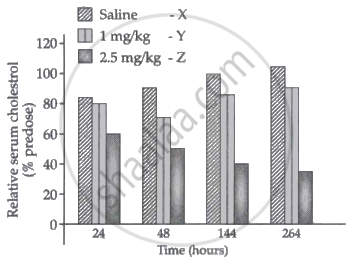Advertisements
Advertisements
प्रश्न
How has the use of Agrobacterium as vectors helped in controlling Meloidogyne incognita infestation in tobacco plants? Explain in the correct sequence.
उत्तर
The following steps were taken utilizing Agrobacterium as a transforming vector for tobacco plants to make them immune against the infestation of a nematode Meloidegyne incognitia:
1) Suitable plasmid vectors are chosen and the specific nematode gene is inserted into it.
2) The recombinant plasmids are introduced into the competent Agrobacterium cells.
3) The transformed Agrobacterium cells are screened and selected to infect the tobacco plants.
4) Agrobacterium infection on the tobacco plant cultures leads to insertion and integration of nematode-desired DNA fragment within the tobacco plant.
5) Correct insertion of nematode gene into the host tobacco plants leads to silencing of an essential housekeeping gene of the Meloidegyne incognitia pest by RNAi.
APPEARS IN
संबंधित प्रश्न
How did the process of RNA interference help to control the nematode from infecting the roots of tobacco plants?
In the following questions/statements has four suggested answers. Rewrite the correct answer
Bt cotton is resistant to:
(A) Insects
(B) Herbicides
(C) Salt
(D) Drought
The trigger for activation of toxin of bacillus thuringlensis is ______.
Golden rice is ______.
Assertion (A): In Bt cotton, B. thuringiensis produces a toxic insecticidal crystalline protein which destroys bollworms.
Reason (R): B. thuringiensis produces this toxic protein in an inactive form, but when an insect ingests this inactive protein, it is converted into active form of toxin due to the alkaline pH of gut which solubilises the crystals, which is responsible for the death of bollworm.
Expand GMO. How is it different from a hybrid?
|
RNA interference (RNAi) holds great potential as a therapeutic agent for the treatment of human diseases and as biocontrol agents in controlling pests in the field agriculture. An experiment was carried to study the use of 'RNAi' for the potential treatment of disorders of cholesterol metabolism. Some people possess genetic mutations with elevated levels of ApoB gene which predisposes them to coronary artery diseases. Lowering the amount ApoB can reduce the number of lipoproteins and lower the blood cholesterol. Tracy Zimmerman and her colleagues used RNAi in 2006 to reduce the level of ApoB in non human primates Cynomolgus monkeys. One group of monkeys were given RNAi treatment (small interfering RNAs, SiRNAs) (doses 1 mg/kg, SiRNAs), second group of monkeys were given RNAi treatment (doses 2.5 mg/kg, SiRNAs) and third group of monkeys were injected with saline. |
The results of the study are depicted in the graph below:

- How does the treatment with 2.5 mg/kg bring an effect on cholesterol metabolism when compared from 24 hours and 144 hours?
- Write any two natural sources from where dsRNA molecule could be obtained for silencing the specific mRNA.
- How is RNAi used in controlling the infection on the roots of tobacco plants by the nematode Meloidogyne incognitia?
With the help of a suitable example, explain how cry-proteins acts as a biological pesticide.
On spraying Bacillus thuringiensis on an infected cotton crop field the pests are killed by the toxin, however the toxin although produced by the bacteria does not affect it. Explain giving reason.
Name an organism that produce cry proteins.
